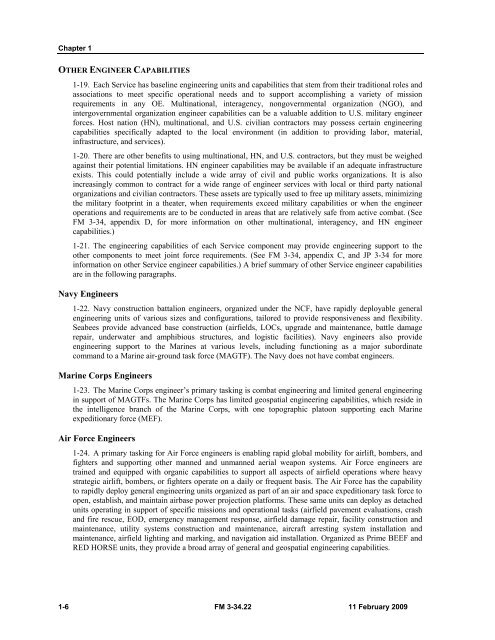FM 3-34.22 - Army Electronic Publications & Forms - U.S. Army
FM 3-34.22 - Army Electronic Publications & Forms - U.S. Army
FM 3-34.22 - Army Electronic Publications & Forms - U.S. Army
You also want an ePaper? Increase the reach of your titles
YUMPU automatically turns print PDFs into web optimized ePapers that Google loves.
Chapter 1<br />
OTHER ENGINEER CAPABILITIES<br />
1-19. Each Service has baseline engineering units and capabilities that stem from their traditional roles and<br />
associations to meet specific operational needs and to support accomplishing a variety of mission<br />
requirements in any OE. Multinational, interagency, nongovernmental organization (NGO), and<br />
intergovernmental organization engineer capabilities can be a valuable addition to U.S. military engineer<br />
forces. Host nation (HN), multinational, and U.S. civilian contractors may possess certain engineering<br />
capabilities specifically adapted to the local environment (in addition to providing labor, material,<br />
infrastructure, and services).<br />
1-20. There are other benefits to using multinational, HN, and U.S. contractors, but they must be weighed<br />
against their potential limitations. HN engineer capabilities may be available if an adequate infrastructure<br />
exists. This could potentially include a wide array of civil and public works organizations. It is also<br />
increasingly common to contract for a wide range of engineer services with local or third party national<br />
organizations and civilian contractors. These assets are typically used to free up military assets, minimizing<br />
the military footprint in a theater, when requirements exceed military capabilities or when the engineer<br />
operations and requirements are to be conducted in areas that are relatively safe from active combat. (See<br />
<strong>FM</strong> 3-34, appendix D, for more information on other multinational, interagency, and HN engineer<br />
capabilities.)<br />
1-21. The engineering capabilities of each Service component may provide engineering support to the<br />
other components to meet joint force requirements. (See <strong>FM</strong> 3-34, appendix C, and JP 3-34 for more<br />
information on other Service engineer capabilities.) A brief summary of other Service engineer capabilities<br />
are in the following paragraphs.<br />
Navy Engineers<br />
1-22. Navy construction battalion engineers, organized under the NCF, have rapidly deployable general<br />
engineering units of various sizes and configurations, tailored to provide responsiveness and flexibility.<br />
Seabees provide advanced base construction (airfields, LOCs, upgrade and maintenance, battle damage<br />
repair, underwater and amphibious structures, and logistic facilities). Navy engineers also provide<br />
engineering support to the Marines at various levels, including functioning as a major subordinate<br />
command to a Marine air-ground task force (MAGTF). The Navy does not have combat engineers.<br />
Marine Corps Engineers<br />
1-23. The Marine Corps engineer’s primary tasking is combat engineering and limited general engineering<br />
in support of MAGTFs. The Marine Corps has limited geospatial engineering capabilities, which reside in<br />
the intelligence branch of the Marine Corps, with one topographic platoon supporting each Marine<br />
expeditionary force (MEF).<br />
Air Force Engineers<br />
1-24. A primary tasking for Air Force engineers is enabling rapid global mobility for airlift, bombers, and<br />
fighters and supporting other manned and unmanned aerial weapon systems. Air Force engineers are<br />
trained and equipped with organic capabilities to support all aspects of airfield operations where heavy<br />
strategic airlift, bombers, or fighters operate on a daily or frequent basis. The Air Force has the capability<br />
to rapidly deploy general engineering units organized as part of an air and space expeditionary task force to<br />
open, establish, and maintain airbase power projection platforms. These same units can deploy as detached<br />
units operating in support of specific missions and operational tasks (airfield pavement evaluations, crash<br />
and fire rescue, EOD, emergency management response, airfield damage repair, facility construction and<br />
maintenance, utility systems construction and maintenance, aircraft arresting system installation and<br />
maintenance, airfield lighting and marking, and navigation aid installation. Organized as Prime BEEF and<br />
RED HORSE units, they provide a broad array of general and geospatial engineering capabilities.<br />
1-6 <strong>FM</strong> 3-<strong>34.22</strong> 11 February 2009

















